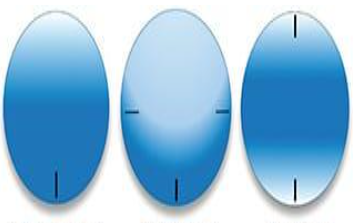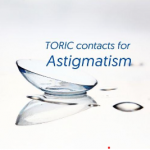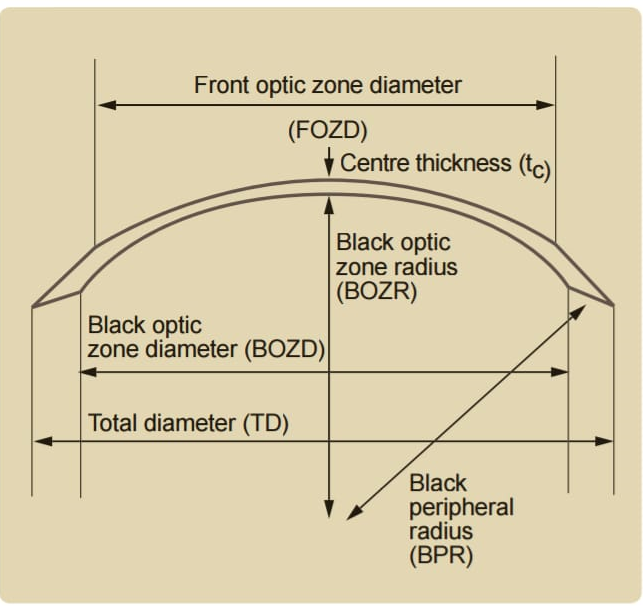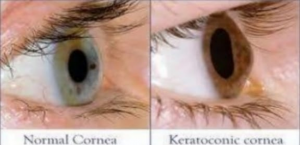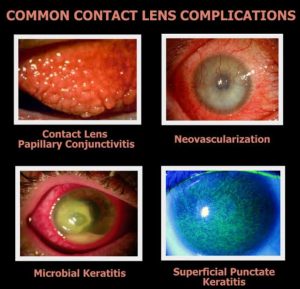Mainly two toric lense are popular , soft toric lens and rigid gas permeable lens .
Toric RGP lens (Front surface toric Rigid gas permeable lens ) :-
These lenses are required in patients having spherical corneas with significant astigmatism . This type of astigmatism is called residual astigmatism and it usually reflects the lenticular astigmatism. When a front toric lens is ordered for a spherical corneal surface, a special change in the shape of the contact lens is necessary to prevent it from rotating .It can be accomplished by the following methods :-
A prism blast may be added to the lens in its manufacture . The amount of base down prism is needed is usually 1.5 D, although more prism may be necessary to centre a high minus power lens.
The lens may be truncated ,i.e . diameter of the lens in one meridian is shortened by cutting of the entire edge of the lens by 0.5-1.0 mm . Truncation is usually used to modify an existing lens rather than as part of the initial lens design
Toric soft lens :- Toric soft lenses are required when astigmatism is more than 1D and spherical soft lenses are not able to correct it , and the patient is unable to tolerate rigid lenses. Toric soft lenses have different radii of curvature in opposing 90 degree meridians . A wide variety of lenses are available with fitting guidelines provided by the manufacturer . All forms of soft toric lenses need to be stabilized so that the toric optics of the lens can be maintained in the desired orientation so as to correct ocular astigmatism. The aim is to minimize rotation from the ideal in –eye orientation . The orientation of a soft toric lens on the eye must be predictable and consistent , otherwise suboptimal vision will result . The development of the technique of dynamic stabilization in the 1980s has resulted in an overall improvement in the performance of soft toric lenses .
Toroidal back surface :- Soft toric lens with a toric back surface will generally locae better than a front surface toric lens , because that the back toric surface is more likely to align, or ‘look on’, to the matching toroidal corneal surface . However , experience has shown that a toroidal back surface alone is insufficient to achieve lens stabilization.
Prism ballast :- Prism ballast is that base – down prism is incorporated into the lens so that the lens will be heavier at the prism base. Gravity then acts to cause the prism base to locate inferiorly. A prism of between 1.00 to 1.50 D is ground base down into the lens . However , greater amounts of prism may be needed for patients with particularly tight lids, flat corneas , or oblique axis astigmatism . The lens will tend to rotate so that the base of the prism is oriented inferiorly . The added thickness of the lens along the prism base can reduce oxygen permeability through that portion of the lens resulting in possible hypoxic disturbance in the inferior zone of the cornea.
Peri- ballast :- This is one of the common stabilization techniques . This method of lens stabilization features a lens with a minus carrier , with the carrier being thicker inferiorly . in other words , the prismatic thickness profile changes are confined to the lens carrier , where the carrier is thicker inferiorly. The design is fabricated simply by removing the high – minus lenticular carrier from the superior portion of the lens . In effect , it is similar to prism ballast except that with peri – ballast all the prism is outside the region of the optic zone.
Truncation :- Truncation refers to the techniques of slicing off the bottom of the lens , so as to form a ‘shelf’ that will rest upon – and therefore align with – the lower lid. This is a reasonably successful method of stabilizing lenses with thick edges, especially when combined with prism ballast. Either a single lower truncation , or a double truncation can be used. With the former , the truncated section of the lens that is removed can be anywhere between a sag of 0.5 and 1.5 mm.
Dynamic stabilization :- Dynamic stabilization was initially developed by Fanti and this is currently the most commonly used method of stabilization for soft toric lenses. With this technique, the dominant lens orientation effect is achieved by pressure from the upper lid and the lower lid . Hanks used the analogy of the ‘water melon seed’ to illustrate how dynamic stabilization works. Simply put, pressure applied to the thin end of a water melon seed by the fingers that the pressure exerted on a thin zone of a lens between the upper lid and globe causes the watermelon seed to move away from the fingers that the causes the lens to orient away from the squeezing force of the eyelid and globe . Hanks demonstrated that the effect of gravity is insignificant , and that the effect of thickness profile interaction with the upper lid.
Read More Article:

